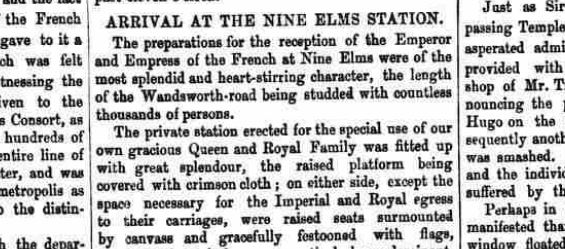In 1854, a new railway station opened in London, but only the Royal Family was allowed to use it — this was Queen Victoria’s Royal Station. Built by the London and South Western Railway it had a short if grand life. The London and South Western Railway built their original railway into London in 1838, opening its terminus at Nine Elms, close to the river to be convenient for the steamboats into the city and the road bridge.
It’s known that the Royal Family used this station to catch trains down to Windsor, or to Southampton where they could catch the boat to Osborne House on the Isle of Wight. The Court Announcements were routinely carried in newspapers at the time, and still, rather less so today, and they record the Queen and Prince Albert catching a royal train from Nine Elms.
However, this was a public railway station and could be used by anyone.
Then in July 1848, the railway company opened an extension to Waterloo, and the Nine Elms station was converted for freight and cargo. Although the Royal Family occasionally used the old terminus, it was now a freight depot, hardly suitable for the head of the British Empire, so a few years later, a dedicated Royal Station was built nearby next to the line that now ran up to Waterloo.
The railway company was presumably motivated as much by patriotic loyalty as the publicity that came from having the Queen travel by the new-fangled railway, and hence attracting fresh customers still wary of this new invention.
The new Royal Station opened in 1854 and initially was just a single platform at street level next to the railway viaduct, with just a canvas awning to protect from the rain.
Quite a comedown for the Queen.
By 1857 though, things looked up, with a proper platform cover added, and what was probably a detached waiting room next to the platform, with a decorative fountain and garden to make waiting more pleasing.
According to Henry Godson, a senior official at Nine Elms, it was “expensively furnished, and the ceiling illuminated in various colours and designs, the execution of which work I watched while in progress”.
The single platform was sufficient for both visitors arriving in London and those heading out as it was hardly a busy station. Although a private railway station, it was a step down in grandeur from the Nine Elms terminus that the Queen was accustomed to using.
The station wasn’t just used by the British Royal Family, but also by foreign dignitaries, who would arrive in London at the station for a state visit.
One of the peculiarities of this station is the apparent lack of any images of it. At a time when newspapers reported on state visits with far more interest than today, and early illustrated newspapers delighted in large drawings of such events, the absence of any images is curious.
I would have expected to see at least one image of the Queen greeting a foreign head of state, considering the news articles of the time about how the streets would be lined with flags and cheering crowds.
The other oddity is that it may never have had a formal name, as it’s usually referred to by its usage, as either the Royal station or the Queen’s station with no apparent regularity.
Following Prince Albert’s death in 1861 and the Queen’s reclusive behaviour, the station fell out of favour, although the Prince of Wales used it occasionally.
However, the railways were now being far more heavily used by ordinary folk, and the railway to Waterloo needed to be widened. The royal station sat right next to the viaduct and was in the way so in 1878 it was swept away to make space for common commuters.
Today nothing remains to be seen of London’s short-lived royal railway station.
Sources
Witness (Edinburgh) – Wednesday 30 August 1843
Newcastle Journal – Saturday 11 July 1846
Morning Post – Monday 11 October 1847
The Railway Age by Cyril Bruyn Andrews
Chronology of London Railways, H V Borley
Private & Untimetabled Railway Stations, Croughton, Kidner & Young
Railway Passenger Stations in England, Scotland and Wales: A Chronology, M E Quick











I can understand the lack of photos but surprised there are no sketches/drawings of it.
I wish I could have seen this railway in its hey day
I wonder if the original plans survived. What became Southern Railway and then BR Southern Region tended to keep all their civil engineering drawings. It might be worth asking Network Rail or the National Railway Museum.
I used to commute from Blackheath into Victoria, and sometimes glimpsed the royal train carriages in their own train shed very near where the station was – just a little to the south. Last time I looked there was still a small shed there.
As a young boy living in vauxhall in the 1960’s I would play on the then abandoned goods yards on nine elms before it vanished to become nine elms market, there were old platforms, signals even a single box, as a bit of side info up at the power station nine elms lane was closed for a short time when required as the coal train would cross into the power station , one other bit of info the last ten minutes if the film villain was filmed on the site if the old railway terminal.
Although it would seem that Queen Victoria would travel via Gosport, rather than Southampton, to Osborne House.
[h2g2.com/edited_entry/A55136450]